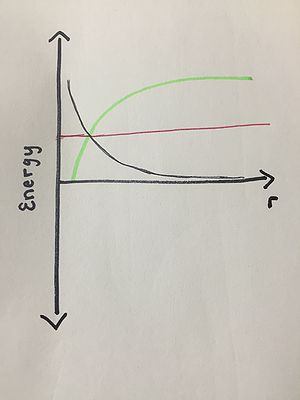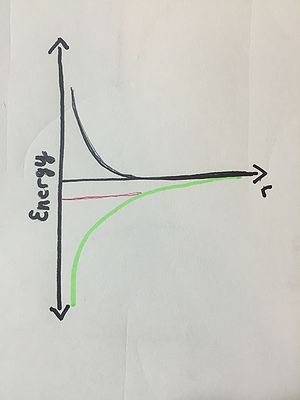Energy Diagrams: Difference between revisions
No edit summary |
|||
| (32 intermediate revisions by the same user not shown) | |||
| Line 1: | Line 1: | ||
Claimed by Julianne Oliver | Claimed by Julianne Oliver | ||
== | ==What is an Energy Diagram?== | ||
[[File:Mainideapic.JPG|center|300px|Example 2]] | |||
Energy Diagrams are extremely useful for analyzing the interactions between two different objects. These diagrams can also be confusing if not properly understood. How do all of the different pieces of an energy diagram fit together? This page serves as a resource on how to construct and interpret energy diagrams. Let's get started! | |||
Energy | ===The Basics=== | ||
Energy diagrams are very useful for understanding different repulsive and attractive situations. These diagrams consist of three main components: kinetic energy, potential energy, and kinetic plus potential energy. These three energies are plotted as a function of energy versus separation between two objects. | |||
Let's review: | |||
'''Kinetic Energy:''' the energy that a moving object has in addition to its rest energy. Kinetic energy is '''K''' on an energy graph. | |||
'''Potential Energy:''' the energy associated with multiparticle systems. This is the energy between interacting objects, and this energy can be either attractive or repulsive. Potential energy is '''U''' on an energy graph. | |||
'''What is the sum?''' Simply the sum of the potential and kinetic energies displayed on the graphs. We will discuss how to plot this value momentarily. '''K+U''' symbolizes the sum of the potential and kinetic energies. | |||
===Positive or Negative?=== | |||
Kinetic energy can NEVER be negative! | |||
Potential energy is negative if the interaction is attractive and positive if the interaction is repulsive. | |||
The sum of the potential and kinetic energies depends on a few factors. If an object can "escape" from an attractive interaction, and, after having escaped, come to rest, then K+U is equal to zero. If however the object can escape with some final velocity, some final speed and motion, then K+U is greater than zero. Lastly, in a '''bound state,''' an object cannot escape the interaction it is involved in, and K+U is less than zero. | |||
===More Important Tidbits=== | |||
K (kinetic energy) is zero or nonzero depending on the motion of the objects. At rest, kinetic energy is zero. In motion, kinetic energy is greater than zero. | |||
In an '''attractive''' interaction, U (potential energy) increases (becomes less negative) and K decreases as two objects move farther away from one another. | |||
In a '''repulsive''' interaction, U(potential energy) decreases and K increases as the two objects move farther away from one another. | |||
The '''x-axis''' is separation, denoted r, and the '''y-axis''' is energy. | |||
===How to construct an energy diagram== | |||
Now that you know the basics, practicing constructing and analyzing energy graphs is the best way to learn! | |||
===A Computational Model=== | ===A Computational Model=== | ||
| Line 16: | Line 37: | ||
==Examples== | ==Examples== | ||
'''See end for solutions to all examples. | |||
''' | |||
===Beginner=== | |||
=== | |||
Label K, U, and K+U on the energy diagrams for the following situations: | Label K, U, and K+U on the energy diagrams for the following situations: | ||
Example 1: | Example 1: | ||
Two electrons are held at rest some finite distance apart, and they move away from each other after they are released. Their initial velocities are zero. | Two electrons are held at rest some finite distance apart, and they move away from each other after they are released. Their initial velocities are zero. | ||
[[File:109.jpg|300px|Example 1]] | |||
Example 2: | Example 2: | ||
A proton and an electron start out far apart. Their initial velocities are | A proton and an electron start out far apart. Their initial velocities are nonzero, and their energy is repulsive. | ||
[[File:111.jpg|300px|Example 2]] | |||
Example 3: | Example 3: | ||
An | An daughter has just enough energy to escape from her controlling mother (they have an attractive relationship). | ||
[[File:JDO78.JPG|300px|Example 3]] | |||
===Intermediate=== | |||
Label K, U, and K+U on the following energy diagrams. THEN, label the following three energy graphs 1, 2, or 3 based on the following scenarios: | |||
1: One of the components of this energy diagram is incorrect. | |||
2: A proton and a electron are at rest, and they start out infinitely far apart. | |||
3: An astronaut orbits the moon. | |||
[[File:JDO78.JPG|300px|Example 1]] | |||
[[File:JDO100.JPG|300px|Example 2]] | |||
[[File:Jdo77.jpg|300px|Example 3]] | |||
===Advanced=== | |||
Create an energy graph for each of the following situations. | |||
Situation 1: A spacecraft is orbiting a moon. The spacecraft is given an initial velocity that allows the spacecraft to leave the moon's orbit with a final velocity greater than zero. | |||
Situation 2: A boy jumps onto a merry-go-round and is attracted to the merry-go-round's axle. The boy's initial velocity is not high enough for him to escape the merry-go-round, so he continues to "orbit" the merry-go-round. | |||
Situation 3: Two people are repulsed by on another and are trying to fight. They are held at rest by two of their friends a finite distant apart, and they of course move away from one another as soon as they are released, since their friends will not let them approach one another. | |||
=== | ===Solutions to Beginner Examples=== | ||
Example 1: [[File:Simpleex1solution.JPG|300px|Example 1]] | |||
Example 2: [[File:Simpleex2solution.JPG|300px|Example 2]] | |||
Example 3: [[File:Simpleex3solution.JPG|300px|Example 3]] | |||
===Solutions to Intermediate Examples=== | |||
Example 1: K+U is incorrect![[File:Intermediateex1solution.JPG|300px|Example 1]] | |||
Example 2:[[File:Intermediateex2solution.JPG|300px|Example 2]] | |||
Example 3:[[File:Intermediateex3solution.JPG|300px|Example 3]] | |||
===Solutions to Advanced Examples=== | |||
Situation 1: [[File:Simpleex2solution.JPG|300px|Situation 1]] | |||
Situation 2: [[File:Advancedex2solution.JPG|300px|Situation 2]] | |||
Situation 3:[[File:Simpleex1solution.JPG|300px|Situation 3]] | |||
==Connectedness== | ==Connectedness== | ||
Latest revision as of 14:11, 29 November 2015
Claimed by Julianne Oliver
What is an Energy Diagram?

Energy Diagrams are extremely useful for analyzing the interactions between two different objects. These diagrams can also be confusing if not properly understood. How do all of the different pieces of an energy diagram fit together? This page serves as a resource on how to construct and interpret energy diagrams. Let's get started!
The Basics
Energy diagrams are very useful for understanding different repulsive and attractive situations. These diagrams consist of three main components: kinetic energy, potential energy, and kinetic plus potential energy. These three energies are plotted as a function of energy versus separation between two objects.
Let's review:
Kinetic Energy: the energy that a moving object has in addition to its rest energy. Kinetic energy is K on an energy graph.
Potential Energy: the energy associated with multiparticle systems. This is the energy between interacting objects, and this energy can be either attractive or repulsive. Potential energy is U on an energy graph.
What is the sum? Simply the sum of the potential and kinetic energies displayed on the graphs. We will discuss how to plot this value momentarily. K+U symbolizes the sum of the potential and kinetic energies.
Positive or Negative?
Kinetic energy can NEVER be negative! Potential energy is negative if the interaction is attractive and positive if the interaction is repulsive. The sum of the potential and kinetic energies depends on a few factors. If an object can "escape" from an attractive interaction, and, after having escaped, come to rest, then K+U is equal to zero. If however the object can escape with some final velocity, some final speed and motion, then K+U is greater than zero. Lastly, in a bound state, an object cannot escape the interaction it is involved in, and K+U is less than zero.
More Important Tidbits
K (kinetic energy) is zero or nonzero depending on the motion of the objects. At rest, kinetic energy is zero. In motion, kinetic energy is greater than zero. In an attractive interaction, U (potential energy) increases (becomes less negative) and K decreases as two objects move farther away from one another. In a repulsive interaction, U(potential energy) decreases and K increases as the two objects move farther away from one another. The x-axis is separation, denoted r, and the y-axis is energy.
=How to construct an energy diagram
Now that you know the basics, practicing constructing and analyzing energy graphs is the best way to learn!
A Computational Model
Vpython is great for modeling this concept. Using vpython, we can model many different systems that have kinetic and potential energy. We can model a spacecraft orbiting the Earth, and we can create graphs to display the kinetic, potential, and kinetic+potential energies of this system. See this code for how to do this!
[Sample Vpython code:https://trinket.io/glowscript/4010e21bc3]
Examples
See end for solutions to all examples.
Beginner
Label K, U, and K+U on the energy diagrams for the following situations:
Example 1:
Two electrons are held at rest some finite distance apart, and they move away from each other after they are released. Their initial velocities are zero.
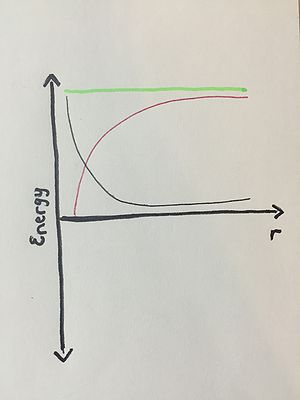
Example 2:
A proton and an electron start out far apart. Their initial velocities are nonzero, and their energy is repulsive.
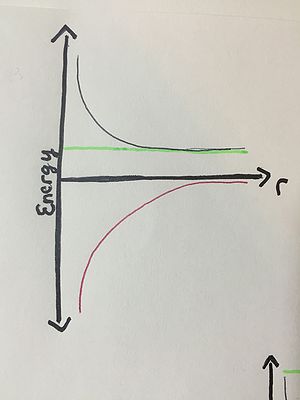
Example 3:
An daughter has just enough energy to escape from her controlling mother (they have an attractive relationship).

Intermediate
Label K, U, and K+U on the following energy diagrams. THEN, label the following three energy graphs 1, 2, or 3 based on the following scenarios:
1: One of the components of this energy diagram is incorrect.
2: A proton and a electron are at rest, and they start out infinitely far apart.
3: An astronaut orbits the moon.
Advanced
Create an energy graph for each of the following situations.
Situation 1: A spacecraft is orbiting a moon. The spacecraft is given an initial velocity that allows the spacecraft to leave the moon's orbit with a final velocity greater than zero.
Situation 2: A boy jumps onto a merry-go-round and is attracted to the merry-go-round's axle. The boy's initial velocity is not high enough for him to escape the merry-go-round, so he continues to "orbit" the merry-go-round.
Situation 3: Two people are repulsed by on another and are trying to fight. They are held at rest by two of their friends a finite distant apart, and they of course move away from one another as soon as they are released, since their friends will not let them approach one another.
Solutions to Beginner Examples
Example 1: 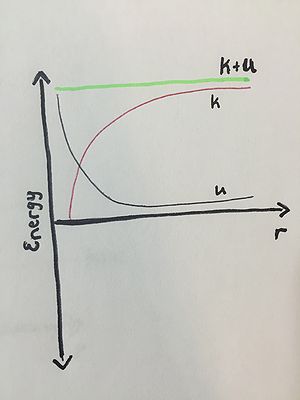
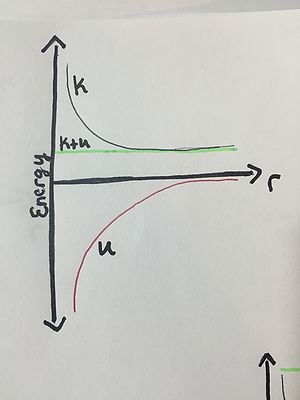
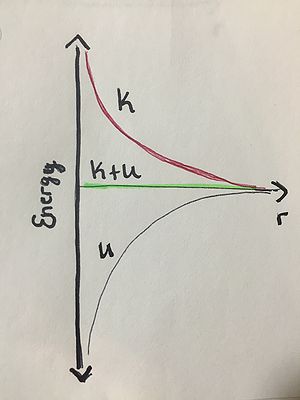
Solutions to Intermediate Examples
Example 1: K+U is incorrect!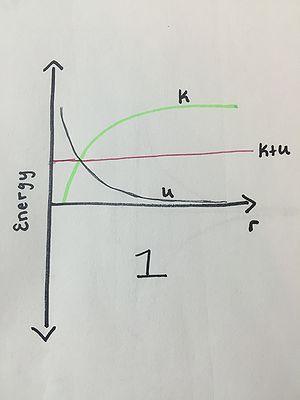
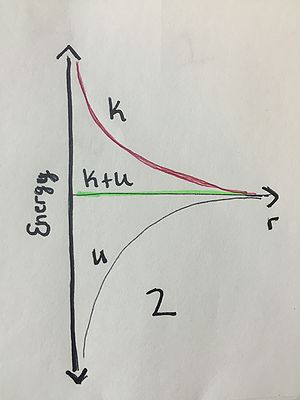
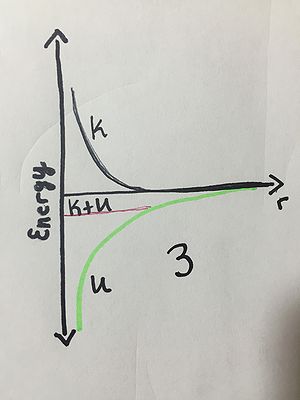
Solutions to Advanced Examples
Situation 1: 
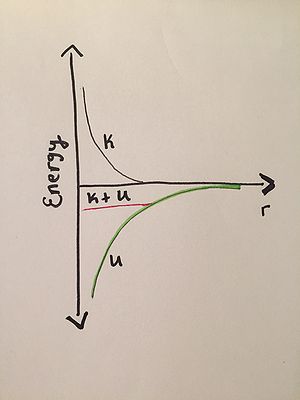

Connectedness
- How is this topic connected to something that you are interested in?
- How is it connected to your major?
- Is there an interesting industrial application?
History
Put this idea in historical context. Give the reader the Who, What, When, Where, and Why.
See also
Are there related topics or categories in this wiki resource for the curious reader to explore? How does this topic fit into that context?
Further reading
Books, Articles or other print media on this topic
External links
Internet resources on this topic
References
This section contains the the references you used while writing this page
